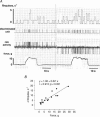Identification and properties of parietal pleural afferents in rabbits
- PMID: 15975985
- PMCID: PMC1474184
- DOI: 10.1113/jphysiol.2005.089029
Identification and properties of parietal pleural afferents in rabbits
Abstract
Although pain and dyspnoea are common symptoms in pleural diseases, there are few studies on the sensory innervation of the pleura. Using rabbits, after removal of all muscles in the intercostal space to be studied, we investigated the afferents of the internal intercostal nerve by applying to the internal thoracic wall pieces of gauze soaked in warmed (37 degrees C), buffered saline (mechanical stimulation) or solutions containing lactic acid, inflammatory mediators or capsaicin (chemical stimulation). The afferent conduction velocity ranged from 0.5 to 14 m s(-1). Most units (97%) were activated by mechanical stimulation of the pleura (local positive pressure range = 4.5-8.5 cmH2O) and we found a linear relationship between the discharge rate of afferents and the force applied to the thoracic wall. The majority of mechanosensitive units (70%) also responded to one or several chemical agents. Thus, the afferents were activated by lactic acid (49%) and/or a mixture of inflammatory mediators (50%). Local application of capsaicin elicited an initial increased or decreased background afferent activity in 57% of the afferents, a delayed decrease in firing rate being noted in some units initially activated by capsaicin. Capsaicin blocked the afferent response to a further application of inflammatory mediators but did not affect the mechanosensitive units. Thus, sensory endings connected with thin myelinated and unmyelinated fibres in the internal intercostal nerve detect the mechanical and chemical events of pleural diseases.
Figures





Similar articles
-
Respiratory and circulatory effects of parietal pleural afferent stimulation in rabbits.J Appl Physiol (1985). 2006 May;100(5):1539-46. doi: 10.1152/japplphysiol.01422.2005. J Appl Physiol (1985). 2006. PMID: 16614364
-
Receptive properties of sacral primary afferent neurons supplying the colon.J Neurophysiol. 1991 May;65(5):1067-77. doi: 10.1152/jn.1991.65.5.1067. J Neurophysiol. 1991. PMID: 1869905
-
The classification and identification of human somatic and parasympathetic nerve fibres including urinary bladder afferents and efferents is preserved following spinal cord injury.Electromyogr Clin Neurophysiol. 2009 Sep-Oct;49(6-7):263-86. Electromyogr Clin Neurophysiol. 2009. PMID: 19845099
-
Receptive properties of primary afferent fibres from rabbit pleura, in vitro.Somatosens Mot Res. 1997;14(4):229-36. doi: 10.1080/08990229770962. Somatosens Mot Res. 1997. PMID: 9443365
-
A novel preparation to study rat pancreatic spinal and vagal mechanosensitive afferents in vitro.Neurogastroenterol Motil. 2008 Sep;20(9):1060-9. doi: 10.1111/j.1365-2982.2008.01141.x. Epub 2008 May 12. Neurogastroenterol Motil. 2008. PMID: 18482253
Cited by
-
Reactive oxygen species activate the group IV muscle afferents in resting and exercising muscle in rats.Pflugers Arch. 2009 Nov;459(1):143-50. doi: 10.1007/s00424-009-0713-8. Epub 2009 Aug 23. Pflugers Arch. 2009. PMID: 19701650
-
Reactive oxygen species and inflammatory mediators enhance muscle spindles mechanosensitivity in rats.Pflugers Arch. 2009 Feb;457(4):877-84. doi: 10.1007/s00424-008-0554-x. Epub 2008 Oct 10. Pflugers Arch. 2009. PMID: 18846383
-
Spinal afferent neurons projecting to the rat lung and pleura express acid sensitive channels.Respir Res. 2006 Jul 1;7(1):96. doi: 10.1186/1465-9921-7-96. Respir Res. 2006. PMID: 16813657 Free PMC article.
References
-
- Amenta F, Cavallotti C, Fabrizi F, Fiorenti C, Laglia G. Cholinergic nerve in the parietal pleura. Acta Histochem. 1982;71:77–81. - PubMed
-
- Artico M, Iannetti G, Trangilli Leali FM, Malinovsky L, Cavallotti C. Nerve fibers-mast cells correlation in the rat parietal pleura. Respir Physiol. 1998;113:181–188. - PubMed
-
- Badier M, Jammes Y, Romero-Colomer P, Lemerre C. Tonic activity in inspiratory muscles and phrenic motoneurons by stimulation of vagal afferents. J Appl Physiol. 1989;66:1613–1619. - PubMed
-
- Blackshaw LA, Page AJ, Partosoedarso ER. Acute effects of capsaicin on gastrointestinal vagal afferents. Neuroscience. 2000;96:407–416. - PubMed
-
- Brook I. Measurements of lactic acid in pleural fluid. Respiration. 1980;40:344–348. - PubMed
MeSH terms
LinkOut - more resources
Full Text Sources

